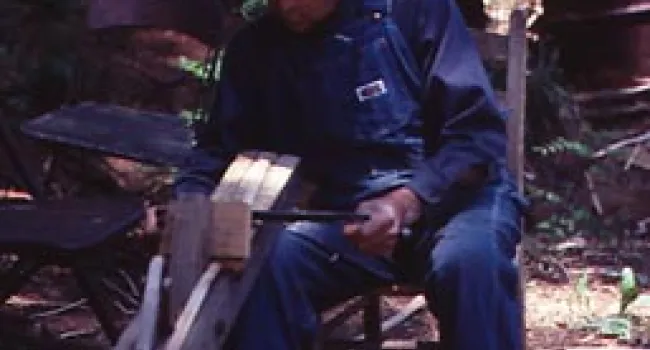
Photo
Elbert Brown of Pendleton crafted split-oak baskets for over eighty years. He carried on a tradition that has been in his South Carolina upcountry family since the mid-nineteenth century. Brown...
Home to a wealth of folk traditions, South Carolina is culturally and geographically diverse. From the Appalachian Mountains to the Sea Islands and from rural crossroads to urban centers, the state boasts rich sources of traditional culture and folklore. Rooted in family and community activities, folklife involves expressive forms of many kinds that are communicated verbally and by observation or imitation. Folk artists can learn through apprenticeships, but most often are taught informally by family members or close friends. This sharing of information can occur in many different group settings - familial, occupational, religious, social, and educational. Folklife is dynamic by nature, a part of a community's history that continues to develop every day, with every generation.
Digital Traditions was developed to provide access to the Folklife Resource Center (FRC) at McKissick Museum. For thirty years, deeply rooted traditions like quilting, pottery, basketry, communal foodways, and folk music have been documented through audio, video, and photography. For further information about any of the artists featured on Digital Traditions, send your questions and comments to hallagan@mailbox.sc.edu.

Photo
Elbert Brown of Pendleton crafted split-oak baskets for over eighty years. He carried on a tradition that has been in his South Carolina upcountry family since the mid-nineteenth century. Brown...
Document
Audio transcript for: Spongeware Glazes Face Jugs, History & Other Potters Effort & Detail To Turn Pots
Photo
Evelyn George was designated a master potter of Catawba pottery by the Catawba Indian Nation. Born in 1914, Ms. George learned as a child from her great-grandmother. She was influenced by individuals...
Audio
NOTE: Transcripts are not available yet for the audio. The use of the shape note method of reading music was an important thread in American musical history. Introduced at the end of the eighteenth...
Audio
A blue grass song sung by Al Wall, from the album Sugar Hill - Remembering Bob Wills. (Written by Bob and John Wills)
Audio
John Price talks about how his family has kept the traditions of family reunions the past 25 years in July.
Audio
J.R. Wilkie, McCormick (McCormick County) realtor who was a musician prior to WWII. Interview conducted by Anne Kimzey.